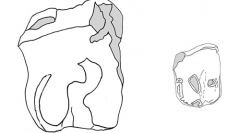

 Comptes Rendus Palevol
18 (4) - Pages 442-448
Comptes Rendus Palevol
18 (4) - Pages 442-448The Rhinocerotidae material from the latest Miocene of Sahabi (Libya) is here revised in detail in order to clarify its systematic position and the paleobiogeographic implications. The family is represented by four specimens only at Sahabi, a phalanx, a mandible, a second upper molar (M2), and a second upper premolar (P2). Except for the phalanx, which can be only identified at the family level, the morphology and the dimensions of these specimens have revealed the presence of three taxa: Aceratheriini vel Teleoceratina, Brachypotherium lewisi and ‘Diceros’ sp. The presence of the large-sized B. lewisi has been suggested in several papers, but without a detailed comparison or critical revision. The Brachypotherium from Sahabi also resembles Brachypotherium heinzelini, suggesting a probable synonymy between this species and B. lewisi. A P2 from Sahabi differs from several species belonging to Ceratotherium, including Ceratotherium neumayri, and it resembles the genus Diceros. The rhinoceros association (Brachypotherium and a dicerotine) recognized at Sahabi has been recorded at Lothagam (Kenya), suggesting a biogeographic affinity with the eastern Africa assemblage.
Brachypotherium, Dicerotine, morphology, systematics, Northern Africa